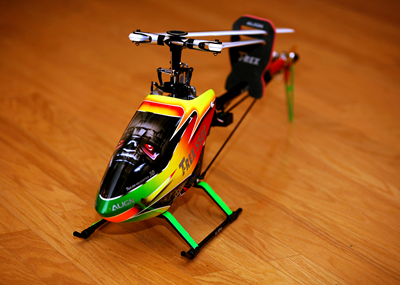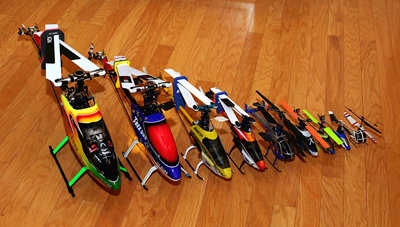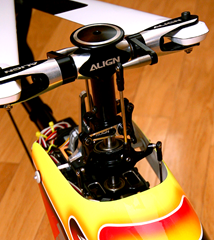Now available on z8rc.com. Please update your bookmarks. Enjoy.

INTRO
Along with my Align TREX 500E review, currently in progress, I’m going to add a 550E for those on the fence between these two awesome machines. Aside from significantly larger size, this helicopter differs from my 500 in that it is flybarless.
SPECS
- Length: 1042mm
- Height: 356mm
- Main Blade Length: 520mm
- Main Rotor Diameter: 1188mm
- Tail Rotor Diameter: 254mm
- Weight (With Motor): 1800g
- Flying Weight: Approx. 2800g
FEATURES
- Align 600MX 1220kV motor
- RCE-BL70G Brushless ESC
- Three Align DS610 digital servo's, one DS620 digital servo
- 520mm carbon fiber rotor blades
- 90mm 3K tail blades
- Align 3GX flybarless system
 REQUIRES
REQUIRES
- 7 Channel Radio
- 6S 5000 mAh LiPo
PAID
- $800
UPGRADES
- None Required
ON THE GROUND
The 550 is a pretty big boy and it looks great…
 |
| TREX 550E, TREX 500E, Blade 400, Blade SR, Blade CX3, Blade 130 X, Blade mCP X, Blade mSR, Blade mCX |
Component quality is industrial grade from nose to tail.
The 550 is only sold as a kit, so barring someone else doing the build for you, there is no such thing as an ARF or RTF version. Some might be put off by that, you are, my advice to you is not to get into serious RC helicopters. The reason is simple: one way or another, you are going to do some damage to the machine, so you will need to understand it, in and out, to maintain and repair it. Repairs take more time than assembly, because you usually have to disassemble first.
Perhaps Ironically, the closer you buy to RTF, the more likely the helicopter is to crash for reasons beyond your control (mechanical or electronic failure) because the amount of time required to put a quality machine together is cost prohibitive, unless you do it yourself.
Like many, I started out with an RTF Blade 400—back when they made those—I never crashed it, it crashed itself. The RTF Blade’s plasticy parts, from nose to tail did not last long enough to really learn how to fly. My advice to those breaking into larger helis is to skip ARF/RTFs entirely. The quality is not sufficient to get you from A to B, so in the long run, and even the short run, you’ll spend much more time keeping the heli maintained and airborne, not less.
Amazingly, Align twists the above discussion into good news. The TREX series of larger heli’s are surprisingly easy to build. The parts are counts is reasonably low and and assembly methods are simple. The 550 is a simpler, more elegant design even that a pretty small copter like a Blade SR. You can build a this kit in a day, start to finish. If the 550 is your first big heli, it could take some just to understand the basic concepts of a torque tube, etc, but learning time is time you’ll spend regardless of helicopter choice.
The basic 550 construction method is a thick carbon fiber frame sandwiching a few basic components, with plenty of room to route leads and cables. The servos are huge (metal gear digitals ) and come straight from Align, as does the matched 600 motor and ESC if you buy the complete kit. The torque tube is easier to build than a belt driven tail, and eliminates any tension calibration guess work, not to mention that it flies so much better.
 My 500 review tests an “old fashioned” TREX with a flybar. This 550 is flybarless. Both fly beautifully. I actually slightly prefer the flybar’ed 500 for a little better inflight feel (I only do light 3D, due to lack of skill so I can’t comment on hard 3D feel). Torque is slightly more evident when maneuvering with a flybar than without, but it is so fundamental to heli flying that isn’t necessarily a bad thing.
My 500 review tests an “old fashioned” TREX with a flybar. This 550 is flybarless. Both fly beautifully. I actually slightly prefer the flybar’ed 500 for a little better inflight feel (I only do light 3D, due to lack of skill so I can’t comment on hard 3D feel). Torque is slightly more evident when maneuvering with a flybar than without, but it is so fundamental to heli flying that isn’t necessarily a bad thing.
Where a flybarless design really shines is in ease of assembly and repair. Make sure all three servos control arms are level, the swashplate is level (unlike the photo, which shows the blades stowed), and connect two perfectly equal length control rods from the swashplate to create a level head, and the helicopter will be very close to mechanically set up right from the first hover. Easy peasy.
As the heli gets bigger, receivers seem to get smaller. I installed a Hitec Optima 9 to enable built-in voltage telemetry, give plenty of control, and immunize the high amp heli against receiver brownouts.
 |
| Applying some brightly colored, self-adhering monokote to the landing gear and tail section improves inflight visibility and helps with orientation. |
BLUF
GENERAL CONTROL
BALANCE & AEROBATICS
POWER SYSTEM
ADVANCED HANDLING CHARACTERISTICS
IN-FLIGHT ISSUES
APPROACH & LANDING
OVERALL
GRADES
Appearance: +
.
Aerodynamics: +
.
Power System: +
.
Build Quality/Durability: +
.
Value: +
.
Overall Grade: +
.
Individual model recommendations are based on an overall grade of B- or higher. This overall tabulation revealed that covers the 67th percentile and higher, of the top-to-bottom grading scale. Roughly the top 2/3rds of the RC universe was good enough to receive the Z8RC stamp of approval.
Congratulations to the corresponding top 2/3rds of manufacturers who’ve received a Z8RC Recommended overall rating, as measured by their objective review performance. Those manufacturers with fewer reviewed models are less statistically significant.
Z8RC is proud to be one of the only sources of objective RC ratings in the world today. Most if not all RC review sites, RC magazines, RC groups and RC forums, take sponsorship money and a host of other forms of legal consideration from the same manufacturers they pretend to review. IOWs, their model “reviews” are nothing but veiled, paid advertisements.
If you see paid advertisements displayed on an RC website that contains a supposed product review, that is not a review at all, it is a bought-and-paid-for sales pitch.